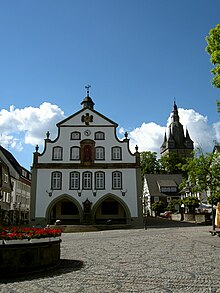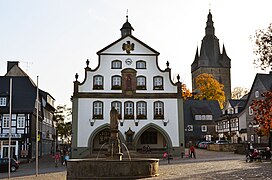Brilon Town Hall
The Brilon town hall on the market square of Brilon is a building that dates back to 1250.
history
Construction probably began in 1217. It is one of the oldest town halls in Germany.
The building served as a guild hall during the Hanseatic League . Local craftsmen and shopkeepers as well as foreign merchants offered their goods here. On February 7, 1574, the council decided to set up a beer cellar under the town hall, in which anyone who registered as a brewer could set up a barrel of beer. People passing through and strangers should be able to get beer and bread. The size of the building (about 52 meters long) underlines the importance of the city as a trading center. Under the Gothic arches at the entrance was the meeting place of the electoral Gogericht .
When Johannes Matthias Kitz remodeled it around 1750 , the facade was redesigned in baroque forms. The Gothic pointed arches were preserved. Since then, the building has had a variety of uses: school, hospital, prison, police station and administration building.
On the first floor, facing the market square, were the large and small Curia halls. The deliberations of the magistrate usually took place in the small room, while the curator met on Martin's Day in the large hall to elect the new magistrate. The hall was also used to represent the reception of dignitaries. There is documentary evidence that images of the electors were hanging here in the 18th century. Presumably, today's Citizens' Hall is roughly on the site of the former large Curia Hall.
In the back of the upper floor the electoral court in Brilon had its seat in two rooms. One room was intended for the incumbent judge, another probably for the clerk and the registry. Serious criminal cases were tried by this court. The execution of the judgments was the job of the city. There was an executioner for the execution of the death penalty. The gallows was on a hill west of the city. The last death sentences were carried out around 1750: a woman and two young men were executed for theft.
Before the town hall on Petrusbrunnen the was pilloried in old records it is called a court Stock. It is mentioned in 1806 that it had been repainted. Dishonorable exposures are passed down several times in city files.
In the 1970s, the town hall was home to the local history museum with reference to local and city history. The town hall was monument of the month in Westphalia-Lippe in June 2013 .
Equipment of the front
Peter figure
The medieval town seals are depicted in the wayside shrine from 1688 above the wide flight of stairs and in the gable . The statue shows Saint Peter , the patron saint of the city. The inscription in the base reads:
- "EXsVrgIt theMIDos reaparata VetVstIor aVLa aVXILIo perstet, Petre, saCrata tVo"
Translated it reads “The renovated, very old court hall rises. With your help it may be established, Peter, since it is consecrated to you. ” The highlighted letters give the year 1755 as a chronogram .
Wayside shrine in front of the town hall
The wayside shrine was first mentioned in a document on November 17, 1688. It is confirmed that the stone carver Sebastian Walck received 9 thalers and 12 groschen because of the contracted Holy House . The year is chiseled in. A verse from the Bible is also chiseled in, which extends over three pages: In nomine jesu flectatur omne genu Coelestium Terrestrium Infernorum (In the name of Jesus, every knee of the heavenly, earthly and subterranean bend).
Overall, the wayside shrine has a height of 3.35 m and a width of 1.20 m. He stands in front of the central axis of the facade above the outside staircase. It was made from green sandstone.
A christogram highlighted by a halo is inserted below the gable crowned with balls .
The niche can be closed with decorative grilles. For more than 250 years, a 1.25 m high wooden Madonna stood in it , which was installed in the town hall hall after its restoration by the State Monuments Office in Münster to protect it from the weather. In the lower part an old coat of arms stone of the former upper gate is attached, which shows the old city coat of arms of Brilon. The coat of arms was added after 1742. In earlier times the emblem was colored in focus .
tower
The hour bell, cast in 1578, hangs in the tower. The following inscription is on the bell: Sit nomen Domini benedictum. Rochus Nelman ne fecit anno Dom. 1578 (Rochus Nelman created me in the year of the Lord 1578). The civil bell in the town hall, which was cast five years later, also comes from the same bell founder.
Others
- The deer antlers on the facade symbolize the former right of the “high hunt” of the city of Brilon.
- The carillon shows scenes of the Schnadegang .
- Views
swell
- ^ Gerhard Brökel: Briloner Heimatbuch, Volume I, p. 28
- ^ Brilon Tourism
- ^ Alfred Bruns: Inventory of the Brilon City Archives, holdings A. Ed. State Office for Archives Maintenance, 1970, p. 158
- ^ Gerhard Brökel: Briloner Heimatbuch, Volume I, pp. 28, 29
- ↑ Urban design and monument protection in urban development, state competition 1977/78, competition performance of the city of Brilon, published by Jürgen Buschmeyer, City of Brilon, p. 12
- ^ Franz Schrewe ( Memento of October 7, 2007 in the Internet Archive )
- ^ Gerhard Brökel: Briloner Heimatbuch, Volume I, Ed. Briloner Heimatbund, 1991, p. 30
- ^ Gerhard Brökel: Briloner Heimatbuch, Volume I, Ed. Briloner Heimatbund, 1991, pp. 30, 31
- ^ Reclam's art guide, Germany III, architectural monuments. 1975, ISBN 3-15-008401-6 , p. 109
- ^ Gerhard Brökel: Past times. ISBN 3-86133-341-4 , pp. 13-15
- ↑ St. Patrokli 954-1976. Ed. St. Patrokli Propsteigemeinde Soest, Dietrich Coelde Verlag, Werl 1976, p. 44
Web links
- LWL monument preservation, landscape and building culture in Westphalia: Monument of the month
- Description on the website of the municipality
Coordinates: 51 ° 23 ′ 42.6 " N , 8 ° 34 ′ 3.8" E







